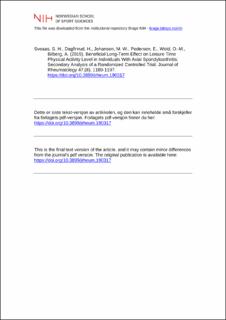| dc.contributor.author | Sveaas, Silje Halvorsen | |
| dc.contributor.author | Dagfinrud, Hanne | |
| dc.contributor.author | Johansen, Melissa Woll | |
| dc.contributor.author | Pedersen, Elisabeth | |
| dc.contributor.author | Wold, Ole-Martin | |
| dc.contributor.author | Bilberg, Annelie | |
| dc.date.accessioned | 2020-12-15T09:21:33Z | |
| dc.date.available | 2020-12-15T09:21:33Z | |
| dc.date.created | 2019-12-20T14:10:20Z | |
| dc.date.issued | 2019 | |
| dc.identifier.citation | Journal of Rheumatology. 2019, 47(8) 1189-1197. | en_US |
| dc.identifier.issn | 0315-162X | |
| dc.identifier.uri | https://hdl.handle.net/11250/2719444 | |
| dc.description | I Brage finner du siste tekst-versjon av artikkelen, og den kan inneholde ubetydelige forskjeller fra forlagets pdf-versjon. Forlagets pdf-versjon finner du på jrheum.org / In Brage you'll find the final text version of the article, and it may contain insignificant differences from the journal's pdf version. The definitive version is available at jrheum.org | en_US |
| dc.description.abstract | Objective: To explore the longterm effect of a 3-month exercise program on leisure time physical activity level in individuals with axial spondyloarthritis (axSpA).
Methods: A secondary analysis was performed on data from 100 individuals with axSpA who were included in a randomized controlled trial. The exercise group (EG) participated in a 3-month exercise program while the control group (CG) received no intervention. Physical activity during leisure time was measured with a questionnaire (physically active: ≥ 1 h/week with moderate/vigorous intensity physical activity). Disease activity was measured with the Ankylosing Spondylitis Disease Activity Scale (ASDAS; higher score = worst). Statistical analyses were performed on an intention-to-treat basis using chi-square tests, logistic regression, and mixed models.
Results: At the 12-month followup, significantly more individuals in the EG than in the CG were physically active [29 (67%) vs 13 (30%), p < 0.001] and exercised 2–3 times/week [25 (58%) vs 15 (34%), p = 0.02], and fewer exercised at light intensity [3 (8%) vs 14 (44%), p = 0.002]. “Participation in the EG” (OR 6.7, 95% CI 2.4–18.6, p < 0.001) and “being physically active at baseline” (OR 4.7, 95% CI 1.4–15.8, p = 0.01) were the factors most associated with being physically active. There were no differences between the groups in ASDAS (p = 0.79).
Conclusion: A 3-month exercise program had a beneficial longterm effect on leisure time physical activity in individuals with axSpA, thus indicating a more beneficial health profile. Still, few individuals continued the intensive program, and there was no difference between the groups in disease activity after 12 months. (ClinicalTrials.gov: NCT02356874) | en_US |
| dc.language.iso | eng | en_US |
| dc.subject | spondyloarthritis | en_US |
| dc.subject | exercise | en_US |
| dc.subject | physical activity | en_US |
| dc.title | Beneficial Long-Term Effect on Leisure Time Physical Activity Level in Individuals With Axial Spondyloarthritis: Secondary Analysis of a Randomized Controlled Trial | en_US |
| dc.type | Peer reviewed | en_US |
| dc.type | Journal article | en_US |
| dc.description.version | acceptedVersion | en_US |
| dc.source.pagenumber | 1189-1197 | en_US |
| dc.source.journal | Journal of Rheumatology | en_US |
| dc.identifier.doi | 10.3899/jrheum.190317 | |
| dc.identifier.cristin | 1763408 | |
| dc.description.localcode | Seksjon for coaching og psykologi / Department of Coaching and Psychology | en_US |
| cristin.ispublished | true | |
| cristin.fulltext | postprint | |
| cristin.qualitycode | 1 | |
